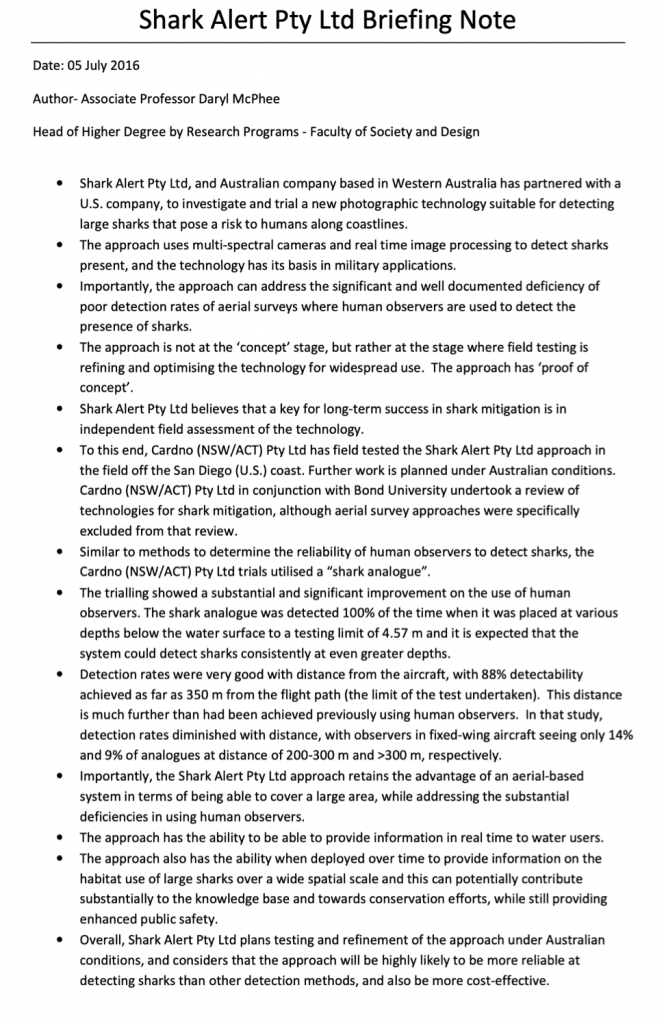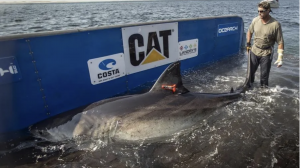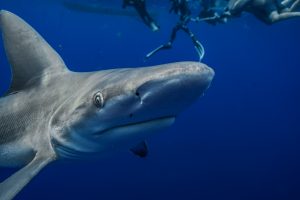A RESTRICTED INVITATION TO ASSESS AND EXPAND
Assembled by Michelle Batterham
The Problem
A paper has been published reviewing various non-lethal methods currently being used, somewhat ineffectively, to reduce interactions between sharks and people.
McPhee et al. 2021, A comparison of alternative systems to catch and kill for mitigating unprovoked shark bite on bathers or surfers at ocean beaches, Ocean and Coastal Management 201(2021): 105492.
I am concerned that this paper will be used as evidence to support the view, which the authors appear to accept, that the only option for control of sharks is non-lethal methods. That is, it is patently circular, the paper restricts itself to a subset of possible solutions, which implies by default, that only these solutions are viable!
I have reviewed the paper and found numerous problems. I would appreciate it if you could assess my findings to date and add or subtract items you think may be important.
The Aim
Is to have a more comprehensive review, and from it, extract a list of condensed bullet points for politicians, establishing why this paper should not be used as evidence of:
a/ The efficacy of non-lethal methods for overcoming human-shark conflict; and,
b/ The efficacy of human-shark conflict being based on prioritising the personal well-being of sharks rather than the victims of shark attacks
Review of McPhee et al. (2021)
The Journal and Authors
Publications, in controversial areas of wildlife conservation and management, are sometimes published in locations that are supportive of particular sides in a controversy. In this case:
1/ The journal seems reputable, with 3 editors, one of which, T.F. Smith, is an Australian Professor, from the University of Sunshine Coast, Maroochydore, whose focus is coastal vulnerability and adaptability. At some time in the past, he worked with CSIRO
Ref: https://www.journals.elsevier.com/ocean-and-coastal-management/editorial- board/t-f-smith).
It is unclear, whether this involves personal involvement in CSIRO shark issues.
2/ The paper would have been peer-reviewed by the journal, but the reviewers are unknown, which is normal, but they are not even acknowledged for contributing to the paper
3/ The study was “in part” funded by the New South Wales Department of Primary Industries, DPI. I do not know who, if anyone, funded “the other part”. It is unknown for example whether national or international NGOs funded any part of this review, although it clearly supports their shark-centric views.
4/ The affiliations of the authors are:
Bond University, D.P. McPhee
Cardno Pty. Ltd, NSW, AC; C. Blount, and M.P. Lincoln Smith Macquarie University, M.P. Lincoln Smith
NSW DPI, V.M. Peddemors
5/ There are no “Acknowledgements” in the paper. Perhaps a requirement of the journal, perhaps no other people assisted or funded the authors for this research or perhaps there are other reasons?
6/ McPhee’s basic credentials are: “I have a long history of fisheries research, including publishing the only book solely dedicated to fisheries management in Australia. Previously I was a Director of the Fisheries Research and Development Corporation. My more recent work has focussed on the issue of the unprovoked shark bite, which is a high profile and expanding area of research. I continue to work on broader issues of environmental impact in the coastal zone, including port developments, desalination, and coastal infrastructure. Ref: https://research.bond.edu.au/en/persons/daryl-mcphee.
7/ All authors declare: “no conflict of interests”. Not sure how Cardno Pty. Limited managed to get around this. Cardno are commercial consultants with sharks and have a vested interest in the non-lethal technologies.
Ref 1: https://www.dpi.nsw.gov.au/__data/assets/pdf_file/0011/578999/cardno- review-of-bather-protection-technologies.pdf
The contribution of his book on Australian fisheries in the eyes of other fisheries professionals in Australia is unknown, as is the claim that it is the only book on the subject.
Ref 2: https://www.environment.gov.au/system/files/pages/e89b07be-c837- 4c34-a41c-561134cd4144/files/greynurse-population-estimation.pdf
The “Shark Alert Pty. Ltd Briefing Note” below suggests an arrangement with Bond University:

8/ Peddemors supports non-lethal solutions to shark management, in his position within the NSW Government fisheries agency.
9/ The observations above (1-8) do not mean that any vested interest nor impropriety, nor advocacy opportunity, has coloured the results. However, it does raise the issue of whether other parties, with a vested interest in non- lethal management methods, have been involved in some way.
The Paper
Title of the paper.
1. The title of the paper is bizarre. It has limited “scientific” value in terms of management interventions for mitigating shark attacks on Australian bathers and swimmers is general. As a summary of “non-lethal” innovations in shark research and management, all of which are problematic, it has value from within that set of options:
- The focus of the authors is on a subset of shark attacks, where it is assumed the shark’s motivation for attacking a person is known, and a that a science-based anthropomorphic decision as to whether the attack was “provoked or not” can be made. As in so many domestic violence problems, it assumes the victim is largely responsible for the “provoked” attacks, with the victim’s role in “unprovoked” attacks not stated.
- The title fails to acknowledge shark “attacks” occur! It strives to replace the word “attack” with the word “bite”, in an obvious attempt to minimise and manipulate the reality that shark attacks are serious. This decision seems completely inconsistent with the vast literature on predator behaviour, and specifically on wildlife-human predation, where science considers the word “attack” a much more realistic way of describing the behaviours that end up with the victims captured, maimed, killed or eaten.
- The recent non-fatal attack on a surfer at Kangaroo Island W.A. was described as: it was like being hit by a truck”. In addition to being “attacked” with such force, he was “bitten” – seriously. Ref:https://www.theislanderonline.com.au/story/7043051/surfer-survives- shark-attack-at-destrees-bay-kangaroo- island/#:~:text=THE%20BAY%3A%20The%20shark%20attack,south%20 coast%20of%20Kangaroo%20Island.
- The use of “bathers” and “surfers”, suggests that other swimmers attacked, are classified under the provoked category and are excluded from consideration. That is, the review is restricted to unspecified “recreational bathers and surfers” in isolation and makes no attempt to relate findings to the full range of problems shark management is expected to resolve, including all shark attacks on people.
1. Introduction
It is clear from the introduction that this paper is not addressed at the public safety problem of minimising human-shark conflict per se. It contributes little in a holistic way to resolving shark management, for all stakeholders, nor does it take the interests of the fishing industries into account.
Nor are the legal and legitimate pursuit of spearfishing and snorkelling, by Indigenous and non-Indigenous people, nor are the socio-economic consequences of shark attacks reducing tourists visiting rural communities, nor the horrific consequences and costs to real people, pursuing legal activities, being killed, and maimed by sharks at an increasing rate.
The context, that the “intrinsic” values of sharks will be held so highly by the Australian public that nothing else matter, may be a goal of the authors but at best it is hypothetical. That a government management agency would have no option but to invest in non-lethal methods, for reducing the probability of people bathing or surfing being attacked, is an assumption. People swimming, that the authors consider were deliberately “provoking” a shark to attack, are ignored.
As such, the introduction sets up a rationale, to some stakeholders a straw man, that seems to underpin the huge effort and public expenditure on non-lethal methods currently being used to deal with sharks – it completely ignores that lethal methods may be more effective.
That this approach is something of a fabrication is suggested by:
- No attempt is made in the paper to define clearly how the authors differentiate between “provoked” versus and “unprovoked” shark attacks. Hence a critical tenant and restriction of the review, is totally ignored.
- The reader is left pondering what “may” motivate a shark to attack people, and what the attributes of “unprovoked” really are, and whether they can be justified from a management perspective.
- The authors fail to articulate the link between increasing shark abundance, increasing shark attacks on people, conservation and management goals, and other social and commercial ramifications of the increasing frequency of shark attacks.
- The authors fail to mention that sharks are commercially fished throughout the world, to feed people for food security. Killing sharks is no different than killing other animals for food. The annual global catch between 2000 and 2015 was conservatively estimated by the United Nations Food and Agriculture Organisation, FAO, at 700,000 to 850,000 tonnes of sharks ref: http://www.fao.org/3/a-i4795e.pdf.
Catching sharks and manipulating abundance to improve the sustainability of shark fishing, is what fisheries management is about.
- Australia’s commercial fisheries catch of sharks, a legitimate harvest for food, of a much-valued food species, was around 7,500 tonnes per year between 2000 and 2015.
- The “endangered” species status of some shark species is accepted uncritically by the authors, despite the lack of even reasonable stock assessment data to verify this status with many species.
- Sharks are not particularly vulnerable to becoming extinct, despite declines in abundance. Of the 1186 species of world “Chondrichthyes”, includes sharks and rays assessed by the International Union for Conservation of Nature’ (IUCN) Red List, none have become extinct despite 4 being considered possibly extinct. Relative to many animals, with many more known or presumed extinct species, sharks are resilient. Ref: https://www.iucnredlist.org/statistics.
- The IUCN “threatened” categories: Vulnerable, Endangered, Critically Endangered, themselves are not real measures of the risk of extinction risk from a fisheries management perspective. Expert fisheries managers for example, FAO Fisheries Experts, have repeatedly demonstrated this within the Convention on International Trade in Endangered Species of Wild Fauna and Flora (CITES) forums and CITES uses different criteria for listing commercial fish species on its Appendices.
- The IUCN Red List categories, to which sharks are assigned, largely by the IUCN-SSC Shark Specialist Group (SSG) have done so in strict accordance with the Red List criteria, ignoring basic fisheries science. They are based largely on known or inferred estimates of the extent of population decline over the preceding three generations. For example, the reference point for considering the status of Great White Sharks as “endangered” is a 50+% decline in the number of adults, in 3 generations. This is assumed to go back to the 1870’s, when no records of abundance exist and when the world (including the population of people) was very different. It is hardly a “hard fisheries science” approach for setting management goals. The increasing numbers of subadults, and increasing biomass, is ignored by the authors.
- Meeting the Red List’s category of “endangered”, means only that the population of adults is guessed or inferred to have declined by 50-80%. There is no risk analysis establishing any danger of extinction from such a decline in these species. A 50% fisheries resource declined by 50% is common in commercial fisheries, and can be rectified by improved fisheries management, over a time span linked to the species life history parameters.
- The authors limit their view of management actions today to those which may politically satisfy members of the public who prioritise, the intrinsic value of sharks, regardless of any biological justification. This is the result of a huge social media campaign, by international non-government organisations, NGOs, intent on using sharks as icons for marine
conservation generally. The end may be admirable, but the means is scientifically questionable.
- Reducing abundance, by excessive harvest, can be expected to reduce the numbers of attacks on people. Hence, there are sound science and logic reasons to assume that by increasing abundance, more attacks will occur, and that the current dramatically increasing rates of attacks, in Australia, are an index that conservation action has worked – shark abundance is increasing.
- To be consistent with public attitudes, and the increasing numbers of people that hold the intrinsic value of sharks highly, the authors seem to unquestioningly accept that “non-lethal” methods of management interventions are needed to reduce the frequency of what they consider “unprovoked” bites on bathers and surfers. The review ignores the victims of unprovoked attacks.
In any overview, the review sets out, for some reason, specifically to review only non-lethal methods, none of which seem highly effective, and makes no attempt to assess the management problem of the shark attacks happening to people, nor to the merits of lethal methods. So, it is not a contribution to the overall problem of reducing shark attacks by management interventions, but rather a summary of the various technologies used, hand in hand with increasing rates of shark attack on people.
2. Occurrence of potentially dangerous sharks and consideration of local Conditions
- Three of the largest predatory sharks, are deemed responsible for most “unprovoked” attacks. Presumably, the same would apply to “provoked” attacks?
- The abundance of large known predators on people, would normally determine management actions in areas where human activities result in attacks. The claim that “understanding of any seasonal occurrence, physiology, behaviour and preferred diet” should be a perquisite for management interventions, to reduce attacks, is questionable.
- Postponing pragmatic action on “what” happens (attacks), while embarking on open-ended research as to “why” it happens from the shark’s viewpoint (research), is arguably macabre. How many people suffered before research the authors refer to resolve that bull sharks, often in highly populated areas, are more likely to attack people when waters are turbid in summer!
- The authors accept that their research confirms specific activities at specific times of year causes increased probabilities of attacks on people! Hence people are being viewed as guinea pigs in these experiments over
time. Helping establish research data sets that can then be interpreted. The direction of the authors is not that decisive management action to reduce the abundance of sharks in hot spots is needed now. Rather, that people should stop their activities in the ocean at times that the accumulating attack data are confirming and particularly dangerous!
3. Overview of the alternatives
- This discussion only considers “non-lethal” alternatives, the best of what may well be completely inadequate management interventions, to solve the problem.
- The assumption is that if you can detect all sharks in an area which is technically impossible and cost-prohibitive, and you had the capacity to warn all bathers and swimmers of the presence of a shark, assuming it will not attack spontaneously, then the probability of attacks should decline.
- Surf lifesavers on some beaches have been doing this for at least the last 100 years. If the ability to detect fails or is not even extended to many areas where people use the water opportunistically, so attacks will continue without the benefit from the technologies being experimented with. Collateral damage to the research.
- Deterrents can reduce the probability of sharks moving into a specific location, with some barriers more effective than others. Or perhaps new innovations can be developed, with further research into the sensory apparatus of sharks. Little comfort to bathers and surfers, who swim legally for customary reasons, where no barriers exist, which is 99.9+% of the Australian coastline – while research continues. Research on shark deterrents has been ongoing since at least WWII.
3.1. Detecting Sharks
- Aerial surveys from aircraft are plagued by visibility biases. Most sharks present are not sighted.
- Aerial surveys from unmanned aerial vehicles such as drones are arguably cheaper to operate but are equally plagued by visibility biases, despite technological sophistication improving sightability rates under some conditions.
- Random sightings of untagged sharks by divers can occur. A reasonable index of abundance perhaps, and of changing abundance over time, but hardly an efficient way of assessing presence, absence, or abundance from a management perspective
- Sonar technologies have technical potential but as yet unrealised.
- Capturing sharks is clearly definitive. But the authors ascribe to the view that it is in the public’s interest to release the sharks after capture! Which means SMART drumlines, in which sharks can be reached before they die, as against conventional lethal fishing. The whole concept of catching a potential predator on people, moving it away and releasing it, raises many issues. How many people have been attacked or killed by sharks that have been caught and released for research?
- The whole concept of reducing abundance by lethal capture is ignored. In reality, access to harvested animals by researchers is an accurate and cost-efficient method of gathering the sorts of biological information on population dynamics, needed to understand population abundance and rates of increase.
- Various other barriers, electrodes, bubble curtains, chemicals etc. are assumed to have potential for the exclusion of sharks in a non-lethal way, based on area use or personal use. None are applicable to the wide range of areas and contexts within which people bathe and surf and are subject to provoked and unprovoked attacks by sharks!
4. Guidelines for establishing protection from potential shark bites
a. Relative to reducing abundance in swimming areas, by direct reduction of shark abundance, the guidelines suggested here are a mishmash of species-specific and location-specific approaches. None meet the public expectation of being effective, in terms of eliminating the risks of shark attacks, in a way that is sustainable, practically or financially, in the long term. Nor are they cost effective relative to direct reduction by lethal fishing methods combined with commercial fishing.
4.1. Small areas of beach or a few small metropolitan, supervised beaches
a. Suggests various methods could be used, subject to environmental factors not interfering with the ability of all methods to overcome visibility and other biases that prevent sharks being detected.
4.2. Many small metropolitan, supervised beaches or large beaches
a. Detection methods with the same visibility and detection biases and limitations.
4.3. Remote, unsupervised beaches
a. Not really practical nor cost-effective.
5. Conclusions
- None of the non-lethal mechanisms work particularly well, but if you have enough resources and multiple methods, you may be able to reduce the probability of attack in a very small number of areas.
- The claim that further research could improve methods and reduce the incidence of attacks basically means more people will continue to be attacked, while research into non-lethal methods continues. The necessity to implement lethal methods for reducing shark abundance are ignored.



